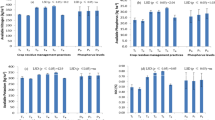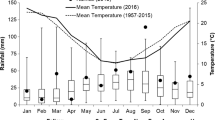Abstract
Crop residues are important sources of organic matter and plant nutrients and known to affect soil quality. Tillage affects residue decomposition and nutrient cycling processes. A 2 year field study was aimed to investigate the decomposition and nutrient dynamics from surface-placed and incorporated rice (Oryza sativa L.) residue on two soil types using the nylon mesh bag technique over wheat cropping cycle in rice–wheat system in northwestern India. A single-pool first-order exponential decay function showed R 2 larger than 0.9. Over the wheat growing cycle about 20% of buried rice residue and 50% of surface-placed residue remained undecomposed. Nitrogen exponential decay models were significant at P < 0.01. At wheat boot stage (1,100 growing degree days, DGD) 12 kg N ha−1 (27% of the initial N) was released from the buried residue losing 60–65% of its N at the end of decomposition cycle. Nitrogen in surface rice residue increased throughout the decomposition cycle due to microbiological immobilization. The change in P with time (DGD) was small and weakly defined by the exponential function. Nutrient dynamics of rice residue indicate that it is not a potential source of N and P for wheat over short-term. The change in K concentration was well described by exponential function (R 2 0.73–0.86). Potassium in rice residue decreased at a fast rate during the initial 20 days (400 DGD) and >80% was released by 40 days (680 DGD).




Similar content being viewed by others
References
Amato M, Ladd JN, Ellington A, Ford G, Mahoney JE, Taylor AC, Walsgott D (1987) Decomposition of plant material in Australian soils. IV. Decomposition in situ of 14C- and 15N-labelled legume and wheat materials in a range of southern Australian soils. Aust J Soil Res 25:95–105
Beare MH (1997) Fungal and bacterial pathways of organic matter decomposition and nitrogen mineralization in arable in arable soils. In: Brussard L, Frrera-Cerrato R (eds) Soil ecology in sustainable agricultural systems. Lewis Publishers, Boca Raton, pp 37–70
Beare MH, Wilson PE, Fraser PM, Butler RC (2002) Management effects of barley residue decomposition, nitrogen release, and crop production. Soil Sci Soc Am J 66:848–856
Bijay-Singh, Shan YH, Johnson-beeebout SE, Yadvinder-Singh, Buresh RJ (2008) Crop residue management for lowland rice-based cropping systems in Asia. Adv Agron 98:117–199
Brown JR, Warencke DD (1998) Recommended cation tests and measures of cation exchange capacity. In: Dhanke WC (ed) Recommended chemical soil test procedures for North Central region. Bull. No. 499. North Dakota Agric. Exp. Stn, Fargo, ND, pp 15–16
Christensen BT (1986) Barley residue decomposition under field conditions: Effect of placement and initial nitrogen content on weight loss and nitrogen dynamics. Soil Biol Biochem 18:523–529
Clement A, Ladha JK, Chalifour FP (1995) Crop residue effects on nitrogen mineralization, microbial biomass, and rice yield in submerged soils. Soil Sci Soc Am J 59:1595–1603
Cookson WR, Beare MH, Wilson PE (1998) Effects of prior crop residue management on microbial properties and crop residue decomposition. Appl Soil Ecol 7:179–188
Frey SD, Elliot ET, Paustian K, Peterson GA (2000) Fungal translocation as a mechanism for soil nitrogen inputs to surface residue decomposition in a no-till ecosystem. Soil Biol Biochem 32:689–698
Ghidey F, Alberts EE (1993) Residue type and placement effects on decomposition: field study and model evaluation. Trans ASAE 36:1611–1617
Gupta RK, Sayre K (2007) Conservation Agriculture in South Asia. J Agri Sci Cambridge 145:207–214
Gupta RK, Yadvinder-Singh, Ladha JK, Bijay-Singh, Jagmohan Singh, Gurpreet Singh, Pathak H (2007) Yield and phosphorus transformations in a rice-wheat system with crop residue and phosphorus management. Soil Sci Soc Am Jl 71:1500–1507
Hassink J, Bouwman LA, Zwart KB, Brussard L (1993) Relationships between habitable pore space, soil biota and mineralizable rates in grassland soils. Soil Biol Biochem 25:47–55
Heal OW, Anderson JM, Swift MJ (1997) Plant residue quality and decomposition: An historical overview. In: Cadisch G, Giller KE (eds) Driven by nature: plant Residue Quality and Decomposition. CAB Int, Cambridge, pp 3–30
Honeycutt CW, Potaro LJ (1990) Field evaluation of heat units for predicting crop residue carbon and nitrogen mineralization. Plant Soil 125:213–220
Keeney DR, Nelson DW (1982) Nitrogen—Inorganic forms. In: Page AL, Miller RH, Keeney DR (eds) Methods of soil analysis. Part 2. 2nd edn. Agron. Monogr. 9. ASA and SSSA, Madison, WI, pp 643–698
Ladha JK, Dawe D, Pathak H, Padre AT, Yadav RL, Bijay-Singh, Yadvinder-Singh, Singh P, Kundu AL, Sakal R, Ram N, Regmi AP, Gami SK, Bhandari AL, Amin K, Yadav CR, Bhattarai EM, Gupta RK, Hobbs PR (2003) How extensive are yield declines in long-term rice–wheat experiments in Asia? Field Crops Res 81:159–180
Ma L, Peterson GA, Ahuja LR, Sherrod L, Shaffer MJ, Rojas KW (1999) Decomposition of surface crop residues in long-term studies of dryland agroecosystems. Agron J 91:401–409
Mclaughlin MJ, Alston AM, Martin JK (1988) Phosphorus cycling in wheat-pasture rotations. I. The source of phosphorus taken up by wheat. Aust J Soil Res 26:323–332
Merckx JR, Den Hartoy A, van Veen JA (1985) Turnover of root-derived material and related microbial biomass formation in soils of different texture. Soil Biol Biochem 17:565–569
Mishra B, Sharma PK, Bronson KF (2001) Decomposition of rice residue and mineralization of carbon, nitrogen, phosphorous and potassium in wheat field soil in Western Uttar Pradesh. J Indian Soc Soil Sci 49:419–424
Olsen SR, Cole CV, Watanabe FS, Dean LA (1954) Estimation of available phosphorus in soils by extraction with sodium bicarbonate. USDA Circ. 939. U.S. Gov. Print Office, Washington
Ordpnez-Fernandz A, Rodríguez-Lizana A, Carbonell R, González P, Perea F (2007) Dynamics of residue decomposition in the field in a dryland rotation under mediterranean climate conditions in southern Spain. Nutr Cycl Agroecosyst 79:243–253
Quemada M (2004) Predicting crop residue decomposition using moisture- adjusted time scales. Nutr Cycl Agroecosyst 70:283–291
Quemada M, Cabrera ML (1995) Carbon and nitrogen mineralization from leaves and stems of four cover crops. Soil Sci Soc Am J 59:471–477
SAS Institute (2000) SAS user’s guide: Statistics. SAS Inst, Cary
Schomberg HH, Steiner JL (1997) Comparison of residue decomposition models used in erosion prediction. Agron J 89: 911–919
Schomberg HH, Steiner JL, Evett SR, Moulin AP (1996) Climatic influence on residue decomposition prediction in the wind erosion prediction system. Theor Appl Climatol 54:5–16
Sidhu HS, Manpreet-Singh, Humphreys EJ, Yadvinder-Singh, Balwinder-Singh, Dhillon SS, Blackwell J, Bector V, Malkeet-Singh, Sarbjeet-Singh (2007) The Happy Seeder enables direct drilling of wheat into rice stubble. Aust J Exptl.Agric 47:844–854
Stroo HF, Bristow KL, Elliott LF, Papendick RI, Campbell GS (1989) Predicting rates of wheat residue decomposition. Soil Sci Soc Am J 53:91–99
Thuy NH, Yuhua S, Bijay-Singh, Wang K, Cai Z, Yadvinder-Singh, Buresh RJ (2008) Nitrogen supply in rice-based cropping systems as affected by crop residue management. Soil Sci Soc Am J 72:514–523
Tian G, Kang BT, Brussaard L (1992) Biological effects of plant residues with contrasting chemical compositions under humid tropical conditions - decomposition and nutrient release. Soil Biol Biochem 24:1051–1060
van Vliet PCJ, Gupta VVSR, Abbot LK (2000) Soil biota and crop residue decomposition during summer and autumn in south-western Australia. Appl Soil Ecol 14:111–114
Varco JJ, Frye WW, Smith MS, MacKown CT (1993) Tillage effects on legume decomposition and transformation of legume and fertilizer nitrogen-15. Soil Sci Soc Am J 57:750–756
Yadvinder-Singh, Ladha JK (2004) Principles and practices of no-tillage systems in rice-wheat systems of Indo-Gangetic plains. In: Lal R, Hobbs P, Uphoff N, Hensen DO (eds) Sustainable agriculture and the international rice-wheat systems. Mercel and Dekker, NY p 167–207
Yadvinder-Singh, Bijay-Singh, Ladha JK, Khind CS, Khera TS, Bueno CS (2004) Effects of residue decomposition on productivity and soil fertility in rice–wheat rotation. Soil Sci Soc Am J 68:854–864
Yadvinder-Singh, Bijay-Singh, Timsina J (2005) Crop residue management for nutrient cycling and improving soil productivity in rice-based cropping systems in the tropics. Adv Agron 85:269–407
Yadvinder-Singh, Gupta RK, Gurpreet-Singh, Jagmohan-Singh, Sidhu HS, Bijay-Singh (2009) Nitrogen and residue management effects on agronomic productivity and nitrogen use efficiency in rice–wheat system in Indian Punjab. Nut Cycl Agroecosys. 84:141–154
Acknowledgments
We are grateful to Indian Council of Agricultural Research for the financial support under the AP Cess fund.
Author information
Authors and Affiliations
Corresponding author
Rights and permissions
About this article
Cite this article
Yadvinder-Singh, Gupta, R.K., Jagmohan-Singh et al. Placement effects on rice residue decomposition and nutrient dynamics on two soil types during wheat cropping in rice–wheat system in northwestern India. Nutr Cycl Agroecosyst 88, 471–480 (2010). https://doi.org/10.1007/s10705-010-9370-8
Received:
Accepted:
Published:
Issue Date:
DOI: https://doi.org/10.1007/s10705-010-9370-8




